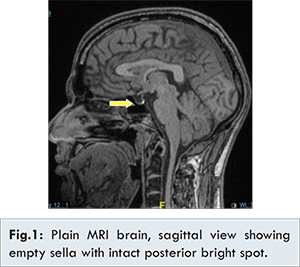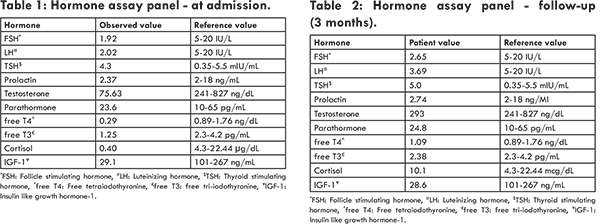Introduction
Vasculotoxic snakes in India belonging to Viperid family include Russell’s viper, Saw scaled viper, Pit viper. Local envenomation and systemic haemostatic abnormalities leading to bleeding and shock occur due to various pro-coagulant and anticoagulant enzymes present in the venom. The resultant complications include acute kidney injury, disseminated intravascular coagulation, capillary leak syndrome, acute respiratory syndrome, etc. Erratic hemodynamic changes result in endocrine gland apoplexy resulting in insufficiency and hence should be considered in these patients. Chatterji et al. in their study of a profile of 86 hypopituitarism patients found that snake bite as an important etiological factor [
1]. Involvement of multiple endocrine glands post-snake bite can occur during acute stage or after months or years [
2]. High index of suspicion is required in such cases. We report a case where the patient presented with symptoms of insufficiency after many months of snake bite. Early hormonal replacement and supportive management is needed to improve the outcome in such cases.
Case Report
A 43 year old gentleman, farmer by occupation presented to us with easy fatigability and generalized myalgia for two months duration. This was accompanied by limb weakness which has progressed to the extent that he needed assistance for walking long distances. During this period he also had two to three fainting episodes which got relieved on drinking fruit juices. He complained of decreased frequency of shaving the beard. Weight gain, constipation and impotence were also present. Patient had a past history of viper snake bite with acute kidney injury and hypotension for which he was treated in intensive care unit, recovered and was evaluated for endocrinopathy at that time but was found to be within normal limits and was discharged.
On examination patient was conscious, oriented and was in depressed mood. He was pale with decreased facial and axillary hair. Skin of the peripheries was coarse, cool and dry with increased pigmentation. Vitiligo of scrotal skin was seen. Haematological and biochemical tests were normal. Thyroid function tests revealed inappropriate normal thyoid stimulating hormone inspite of low free tetra and tri-iodothyronine, hence primary hypothyroidism was suspected and further hormonal assays were done which had the following pattern as given in Table 1. The hormone assay panel of the patient revealed that there is pan-hypopituitarism with primary adrenal insufficiency. MRI brain showed empty sella with intact posterior bright spot as in Fig.1. Patient was started on prednisolone along with thyroxine and fortnightly testosterone injection. Prompt improvement in general condition of the patient within weeks of starting replacement was seen. Steroid and thyroxine replacement was continued and regular hormone level assay was done. Patient recovered completely and was followed up regularly. Table 2 shows hormone profile at 3 months follow-up.


Multiple endocrine gland insufficiencies, including hypopituitarism and adrenal insufficiency are commonly encountered entities in general practice. The prevalence and etiologies of these endocrine deficiencies are different between tropical countries and the West [
1]. Among the numerous causes known, post-snake bite multiple endocrine gland insufficiency should be considered with high index of suspicion in tropical countries like India [
2]. Vasculotoxic ophitoxemia is well known to occur following viperid snake bite [
3]. The possible mechanisms include coagulation activating enzymes in viper venom, direct endothelial damage, abnormal platelet function, etc [
4,
5]. All these factors result in microthrombi formation associated with shock due to envenomation resulting in pituitary insufficiency, adrenal failure, etc. [
6-
9].
Our patient had insidious onset of vague symptoms like easy fatigability, giddiness, etc. On further detailed analysis of the patient, significant past history of snake bite with vasculotoxic complications was obtained. Further investigation showed pan-hypopituitarism associated with adrenal insufficiency by hormonal assay, a combination seen only in a few post-snake patients in the prior case reports. MRI brain showing empty sella turcica further supported our diagnosis. Following prompt hormonal replacement, significant recovery from symptoms was seen. Thus good clinical suspicion and timely intervention with steroids and other hormone replacement is very important.
Conclusion
Physicians while treating viperid snake bite patients should also have suspicion of polyendocrinopathy along with the usual vascular complications. Failure of one or more endocrine gland may occur not only in the acute phase but also after several months as seen in our case. Though pituitary is the commonest gland to be involved other endocrine glands especially adrenal gland should also be considered. Hence high degree of suspicion and hormone replacement is required at the earliest.
References
- Chatterjee P, Mukhopadhyay P, Pandit K, Roychowdhury B, Sarkar D, Mukherjee S, et al. Profile of hypopituitarism in a tertiary care hospital of eastern India: Is quality of life different in patients with growth hormone deficiency. J Indian Med Assoc. 2008;106:384-385.
- Dhanwal DK, Das AK. Hypopituitarism following snake bite. J Assoc Physicians India. 1998;46:322.
- Kalra S, Dhanwal D, Vaman K. Hypopituitarism in the tropics. Indian Journal of Endocrinology and Metabolism. 2011;15:151-153.
- Antonypillai CN, Wass JA, Warrell DA, Rajaratnam HN. Hypopituitarism following envenoming by Russell’s vipers (Daboiasiamensis and D. russelii) resembling Sheehan’s syndrome: First case report from Sri Lanka, a review of the literature and recommendations for endocrine management. QJM. 2011;104:97-108.
- Than-Than, Fancis N, Tin Nu, Myint Lwin, TunPe, Soe-soe, et al. Contribution of focal hemmorage and microvascular fibrin deposition to fatal envenoming by Russell viper in Burma. Acta Trop. 1989;46:23-38.
- Uberoi HS, Achuthan AC, Kasthuri AS, Kolhe VS, Rao KR, Dugal JS. Hypopituitarism following snake bite. J Assoc Physicians India. 1991;39(7):579-580.
- Devaraj T. Bleeding manifestations in snake bite. Southeast Asian J Trop Med Public Health. 1979;10(2):255-257.
- Denson KWE. Coagulant and anti-coagulant action of snake venom. Toxicon. 1969;7:5.
- Braud S, Bon C, Wisner A. Snake venom proteins acting on hemostasis. Biochimie. 2000;82:851-859.